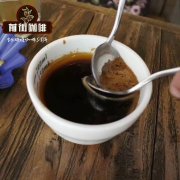How would you describe the taste of good coffee? How to tell what kind of coffee tastes good at Starbucks?

Professional coffee knowledge exchange More coffee bean information Please pay attention to coffee workshop (Weixin Official Accounts cafe_style)
Coffee taste description
● Texture, Mouthfeel
Texture refers to the thick, sticky feel of coffee in the mouth, which is approximately proportional to the amount of colloidal suspension in coffee. Because the whole mouth will feel the texture, we use "rich" to describe the texture of thick coffee, otherwise we use "thin". Thin coffee tastes like wine or lemonade, while rich coffee tastes like whole milk or even syrup.
● Back to sweet, finish (Finish)
The aftertaste refers to the sensation left in the mouth, throat and esophagus after coffee is swallowed or spit out. Freshness is the most important factor causing sweetness. After drinking Espresso coffee made from fresh coffee beans, in addition to the aroma of coffee remaining from the mouth to the esophagus and the aftertaste after being stimulated, the throat will also have a numbing feeling, lasting about two or three minutes; and the whole intoxicating aftertaste will disappear after thirty or forty minutes, which can be said to be lingering. The sweetness fills your breath with aromas that make you reluctant to dilute it with water; this is very different from the unpleasant pungency, irritation and dryness of over-extraction.
Sweet (sweet)
When we say,"This soup is sweet," we don't necessarily mean that there is a lot of sugar in the soup; similarly, in describing the taste of coffee, sweet has two meanings. The first is the stimulation of sugar on the tip of the tongue, which is generally called sweetness; the other means that between full-city roasting and espresso roasting (before and after the oil begins), due to the disappearance of some astringent substances, coffee has a low acid, round and soft, rich and mellow taste, reminiscent of syrup; here the tongue does not have to react.
● Irritant, bitter
This is a characteristic of deep-baked beans and, like sourness, is not necessarily unpleasant. The irritation is a bit like the taste of soda, the sensation of the whole mouth and throat, not just the tongue. A friend who drinks American coffee or espresso coffee may describe this characteristic as "strong".
Earthiness, wildness
A coffee taste defect is usually found in dry-processed coffee in some ways: it's a soda-like sensation with a slightly unpleasant acid mixed in with a pleasant acid; mocha sourness is typical. Sometimes a trace of earthy or slightly pungent earthy ginger can inject life into coffee--actually making the senses more alert.
Clean (Clean)
Coffee is not earthy, not wild, and free of flaws and dazzling features; washed Colombia is an example.
● Smooth
A sweet espresso that has a weak acidity and pungency, occasionally adds a little sugar, and can be drunk comfortably without milk.
Complexity (Complexity)
The coexistence of different levels of characteristics in the same cup of coffee, high complexity indicates that there are many kinds of sensory stimuli that can be felt; it should be noted that these feelings include aftertaste, not necessarily limited to the current feeling of drinking.
Balance (Balance)
There are complex and interesting features, but none stand out.
● Depth
This is a subjective adjective, referring to resonance and appeal beyond sensory stimulation, which is caused by some detailed feelings or complex interaction between different feelings.
Other commonly used words include aroma, richness, flavor, varietal distinction or character, etc. I think some can be taken literally, some meaning is too vague, beyond my ability, so I will not write more. Mastering these taste vocabulary not only allows us to introduce the characteristics of coffee beans in more detail, but also enables us to describe our own taste and better understand our own preferences.
Important Notice :
前街咖啡 FrontStreet Coffee has moved to new addredd:
FrontStreet Coffee Address: 315,Donghua East Road,GuangZhou
Tel:020 38364473
- Prev

Coffee words commonly used to explain the taste of boutique coffee
Professional coffee knowledge exchange more coffee bean information please pay attention to the coffee workshop (Wechat official account cafe_style) have the impression, every time you go to the coffee shop, when you order a cup of coffee, or choose a bag of boutique coffee beans, the boss will be beaming, dancing to say a lot of technical terms to describe the flavor and taste of coffee, often sounds beautiful and dreamy, but
- Next

How to describe the taste of coffee to make it look like a literary and artistic style? There is even a human analogy operation?
Professional coffee knowledge exchange more coffee bean information Please follow the coffee workshop (Wechat official account cafe_style) the boss accidentally bought brother coffee beans, the guests have to drink the coffee sold by the brothers. The turtle beans of Galapagos are so full that they can stand even after drinking a glass of Panamanian geisha
Related
- Beginners will see the "Coffee pull flower" guide!
- What is the difference between ice blog purified milk and ordinary milk coffee?
- Why is the Philippines the largest producer of crops in Liberia?
- For coffee extraction, should the fine powder be retained?
- How does extracted espresso fill pressed powder? How much strength does it take to press the powder?
- How to make jasmine cold extract coffee? Is the jasmine + latte good?
- Will this little toy really make the coffee taste better? How does Lily Drip affect coffee extraction?
- Will the action of slapping the filter cup also affect coffee extraction?
- What's the difference between powder-to-water ratio and powder-to-liquid ratio?
- What is the Ethiopian local species? What does it have to do with Heirloom native species?

